evealing the Tuileries palace from the Louvre © French Moments
From the Place du Carrousel, the Jardin des Tuileries offers an unbroken vista along the centreline of the Historical Axis towards the Place de la Concorde, the Arc de Triomphe and the Grande Arche.
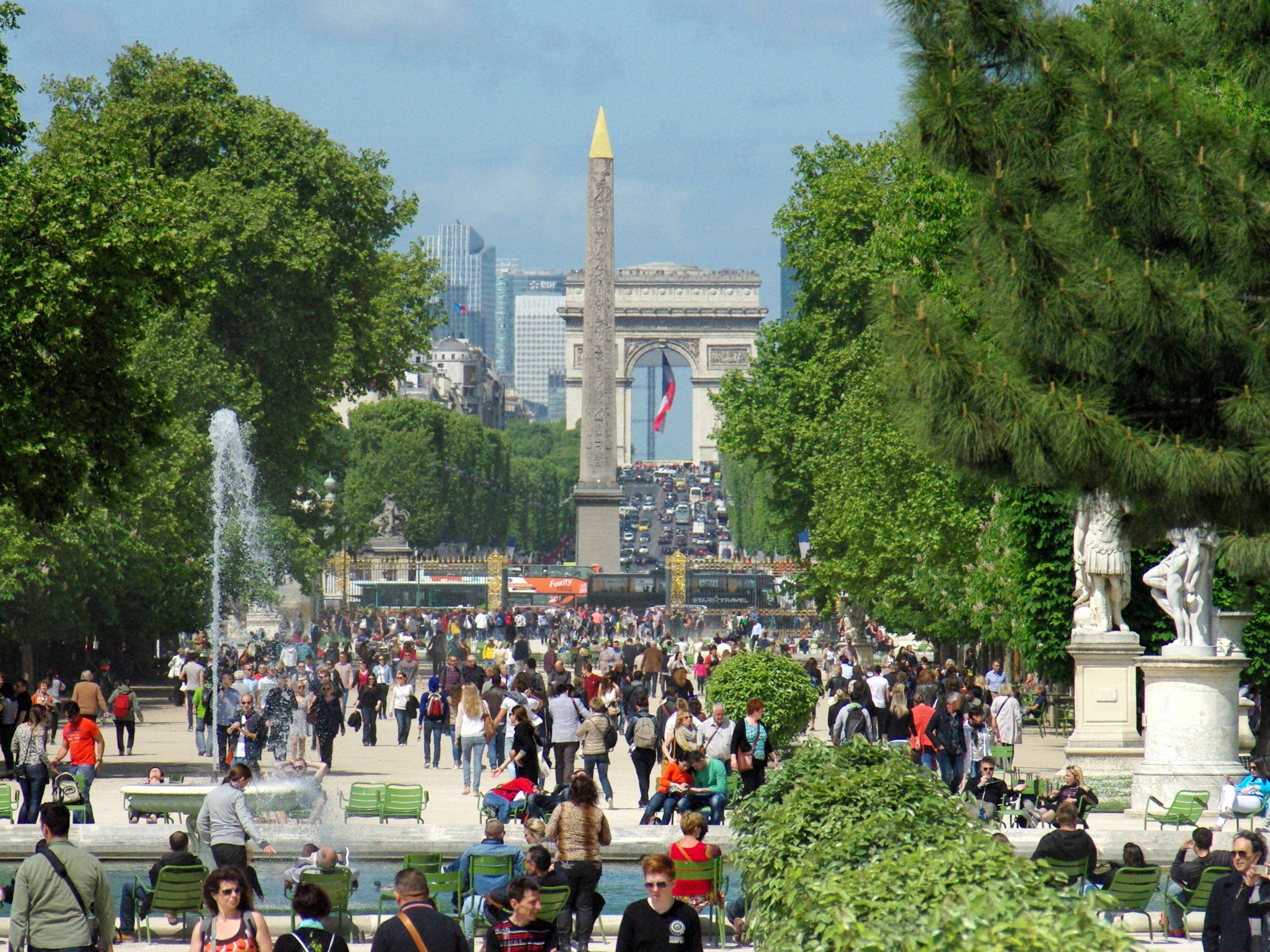 The Historical Axis at the Tuileries garden seen from the Louvre © French Moments
The Historical Axis at the Tuileries garden seen from the Louvre © French Moments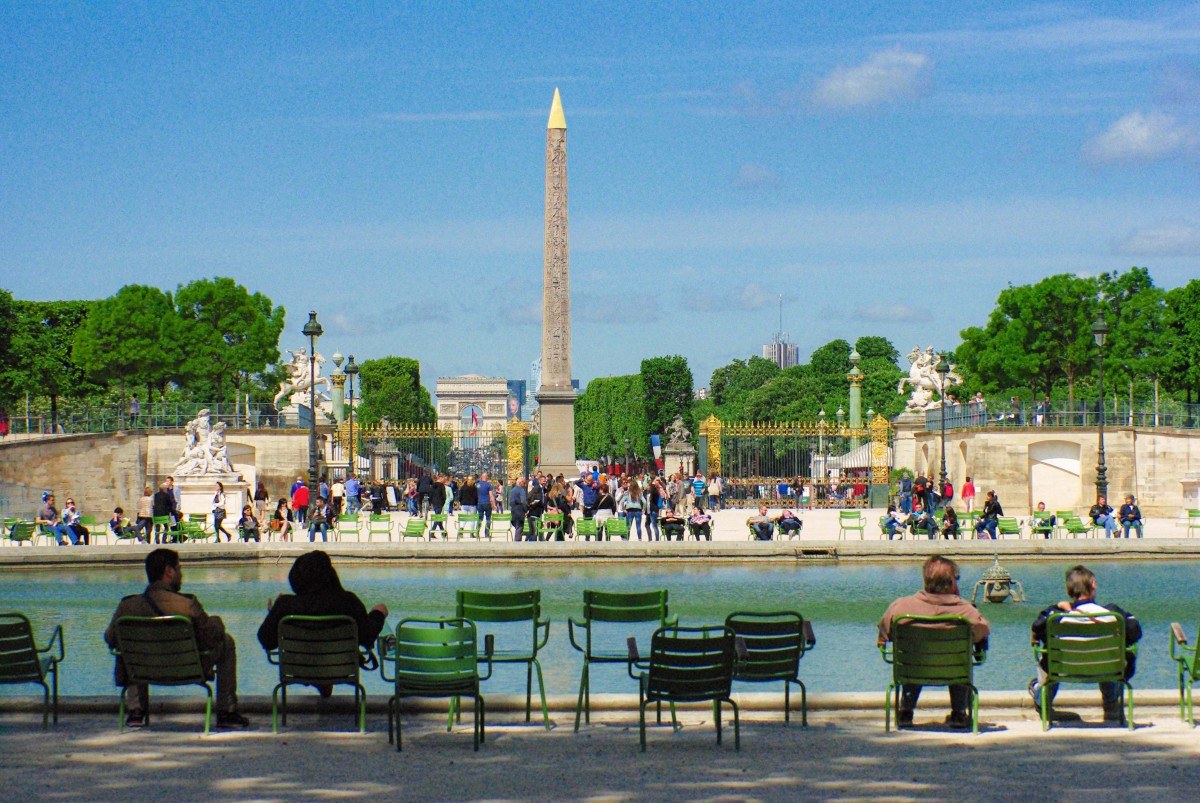 The Historical Axis of Paris in the Tuileries garden near place de la Concorde © French Moments
The Historical Axis of Paris in the Tuileries garden near place de la Concorde © French Moments
The view across the Tuileries Garden towards the Louvre:
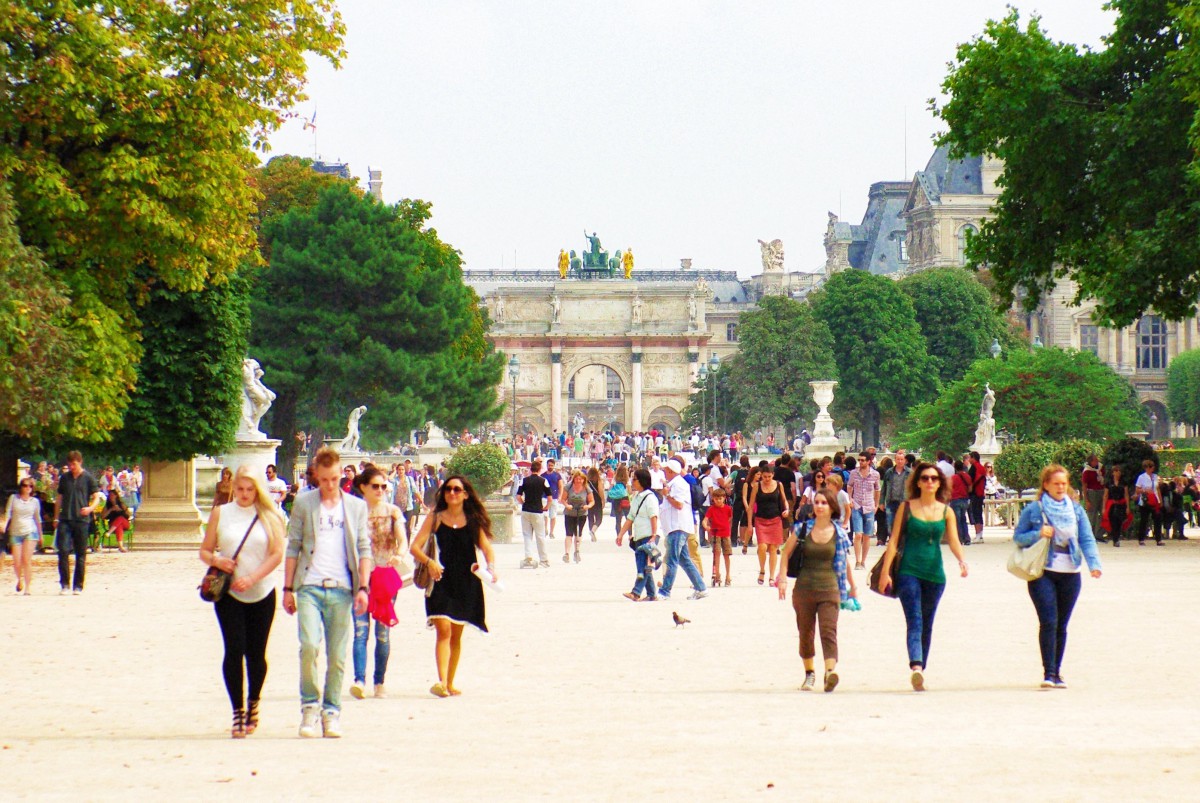 The Historical Axis designed by Le Nôtre at the Tuileries garden (towards the Louvre) © French Moments
The Historical Axis designed by Le Nôtre at the Tuileries garden (towards the Louvre) © French Moments
Find out more about the Tuileries Palace and the Tuileries Garden.
Place de la Concorde
Place de la Concorde is one of my favourite squares in Paris. It is a grand, monumental and open square that offers spectacular views on the perspective of the Champs-Elysées and the Eiffel Tower.
 Arc de Triomphe from Place de la Concorde © French Moments
Arc de Triomphe from Place de la Concorde © French Moments Place de la concorde and Eiffel Tower, Paris © French Moments
Place de la concorde and Eiffel Tower, Paris © French Moments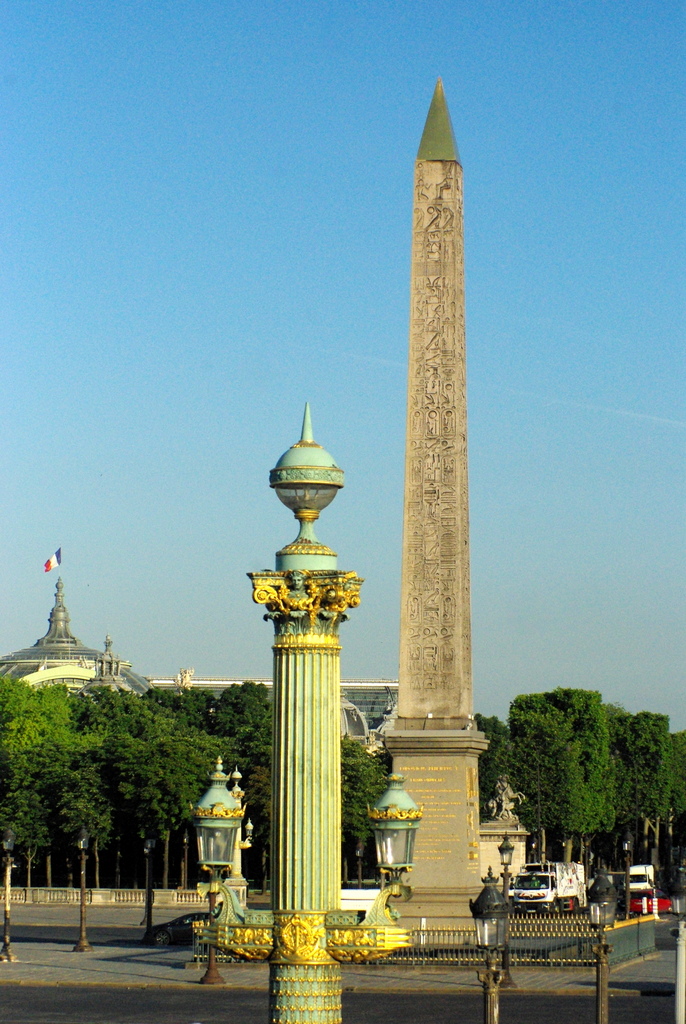 Place de la Concorde © French Moments
Place de la Concorde © French Moments
The majestic Place de la Concorde takes the form of an octagon measuring 359 by 212 metres. The River Seine borders its South side and classical-style buildings close its North front.
In the middle of the square stands an Egyptian Obelisk, raised there in 1836. The monument is part of the strange geometrical layouts and alignments along the Historical Axis, referring to the symbols of Ancient Egypt.
In 1988, another pharaoh-related structure joined this great Egyptian landmark along the Historical: the Glass Pyramid in the Louvre. This modern monument unmistakably refers to the Great Pyramid of Giza.
Place de la Concorde is also the centre of a much-shorter North-South perspective, perpendicular to the Historical Axis.

On the South side, beyond the Pont de la Concorde, it features the Palais Bourbon. On the North side, at the end of Rue Royale, the Madeleine Church closes the perspective. Both monuments match each other across the Place de la Concorde. Their grand Classical-style porticos refer to the design of Roman temples.
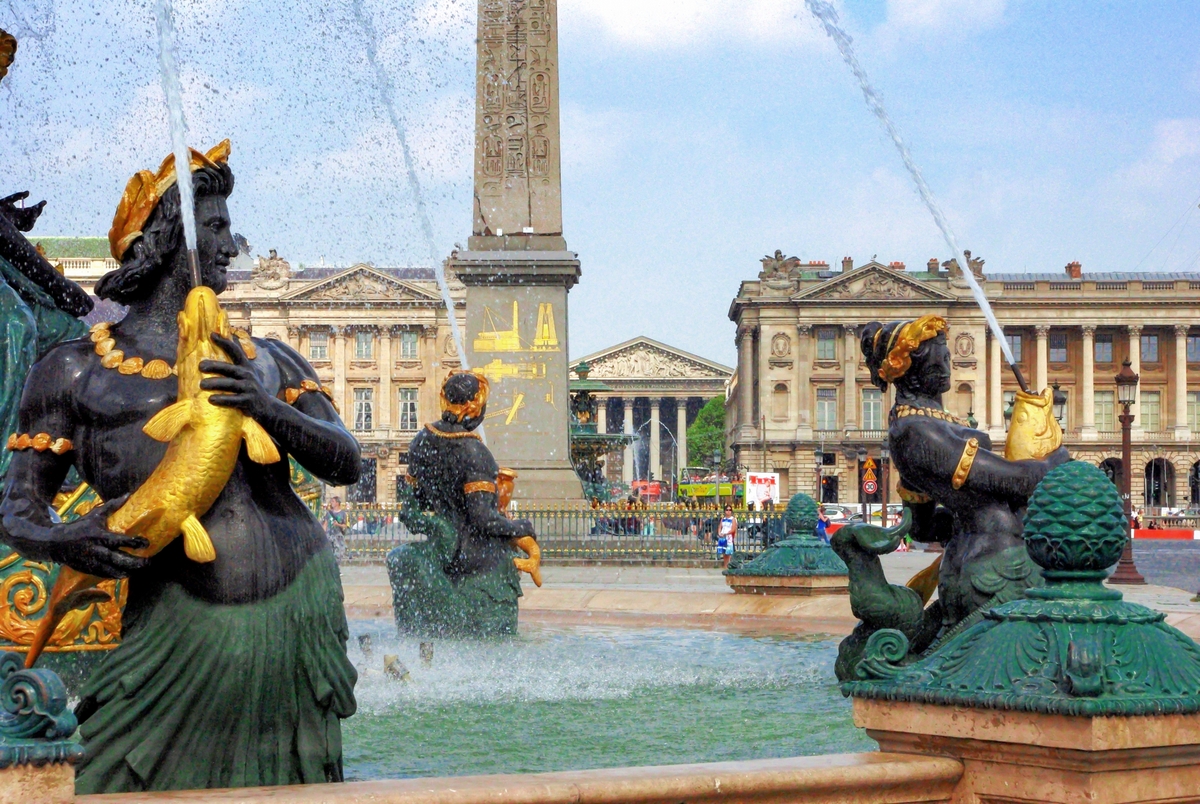 The fountain of the seas in Place de la Concorde © French Moments
The fountain of the seas in Place de la Concorde © French Moments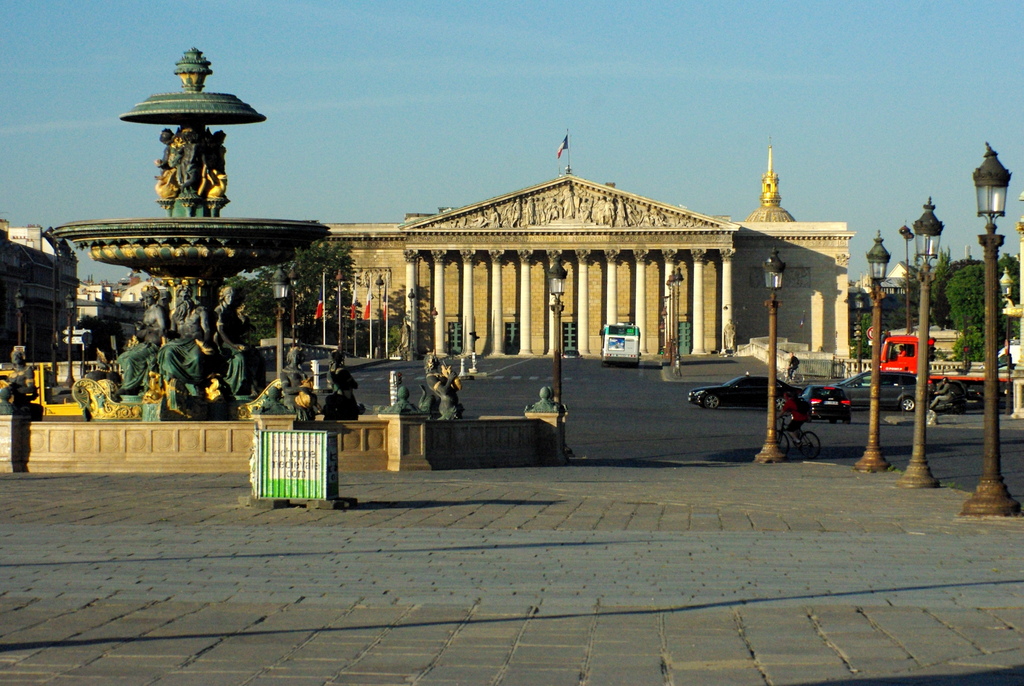 Palais Bourbon from Place de la Concorde © French Moments
Palais Bourbon from Place de la Concorde © French Moments
Read more about the position of the Place de la Concorde along the Historical Axis of Paris.
Avenue des Champs-Élysées
 Avenue des Champs-Élysées and Arc de Triomphe © French Moments
Avenue des Champs-Élysées and Arc de Triomphe © French Moments
The urban architect Le Nôtre had the Champs-Élysées in mind when he designed the Tuileries Garden back in the 17th century.
But it was the Duke of Antin who pursued the Grand Cours or ‘Perspective’ up to the hillock of Chaillot (Butte de Chaillot) where the majestic Arc de Triomphe now stands.
As a famous landmark along the Historical Axis, the wide processional avenue plays a major role in opening the outlook from the Louvre towards the West. Towards the setting sun.
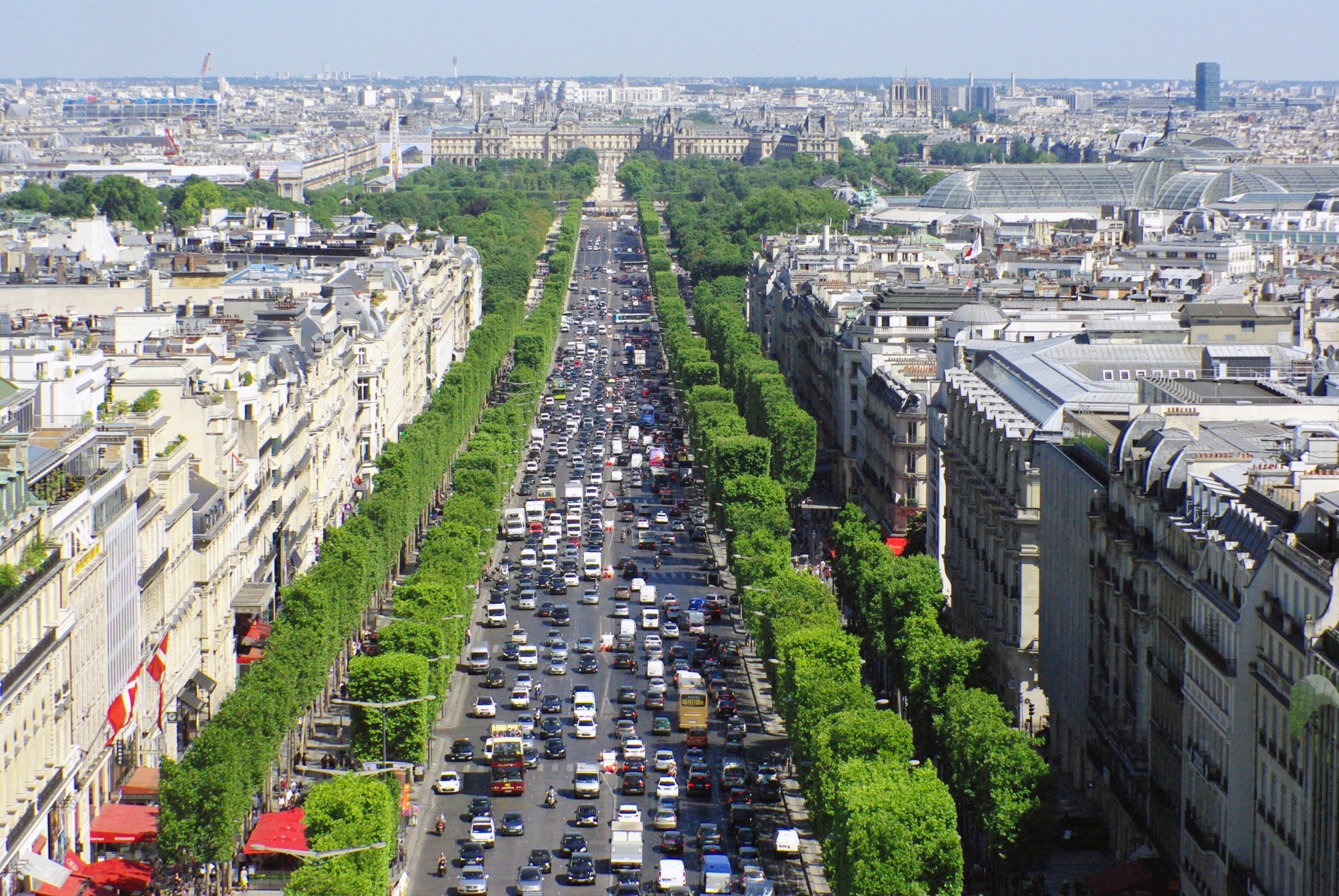 View of the Champs-Élysées from the top © French Moments
View of the Champs-Élysées from the top © French Moments
The Republican Axis
From the Place Clemenceau is another ‘Grand Perspective’.
It opens towards the Hôtel des Invalides, passes through the Grand Palais and the Petit Palais, the Pont Alexandre III and the Esplanade des Invalides.

Because it was completed during the Third Republic, it was commonly known as the “Republican Axis”. Therefore it echoes the older “Historical Axis” along the Champs-Elysées.
Read more about the position of the Champs-Élysées along the Historical Axis of Paris.
The Arc de Triomphe de l’Etoile
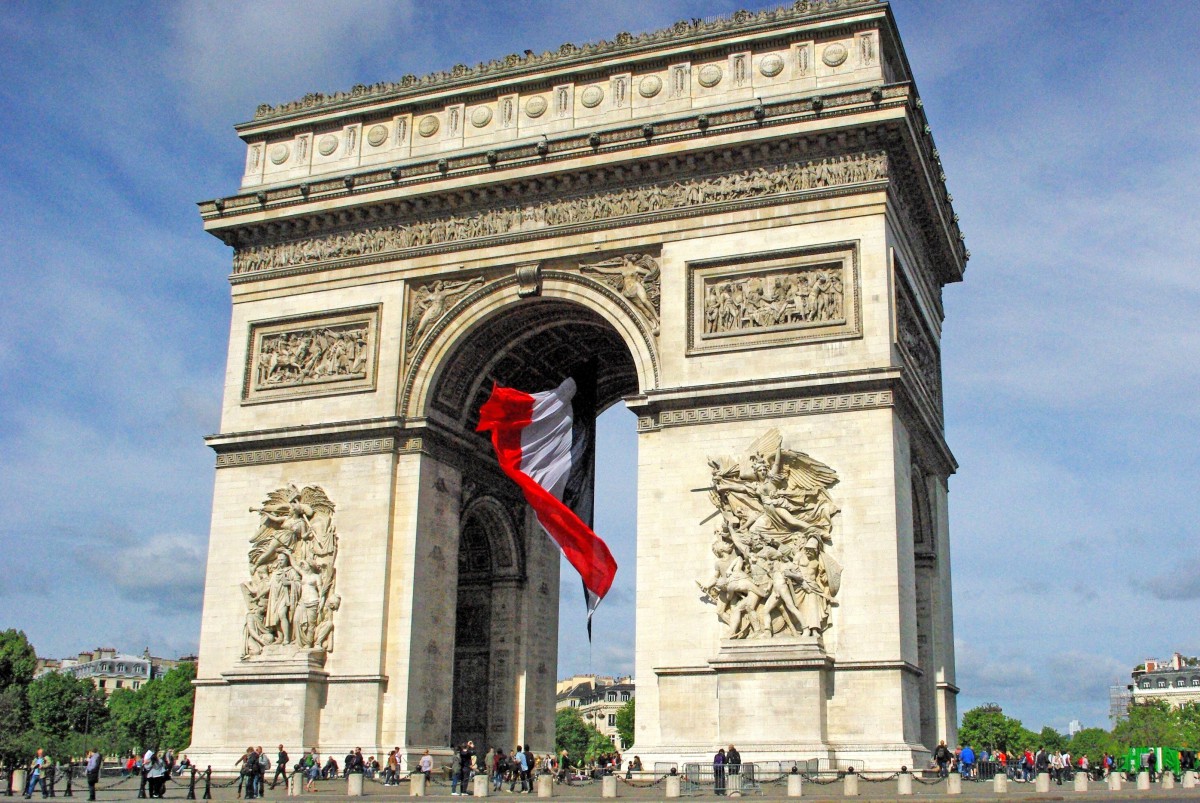 Arc de Triomphe © French Moments
Arc de Triomphe © French Moments
At the end of the Avenue des Champs-Elysées stands the mighty Arc de Triomphe.
The triumphal arch rises at the centre of a huge square in the shape of a ‘star’, accurately named the “Place de l’Étoile”.
The huge monument dates back to the 19th century. It commands a strategic point on the centreline of the Historical Axis of Paris. It lies some 2.2km from the Luxor Obelisk on Place de la Concorde. This celebrated monument is the highest triumphal arch in Europe and stands 50 metres high.
The Arc de Triomphe honours those who fought for France, particularly during the Napoleonic Wars. The monument is certainly a symbolic monument with a strong historic connotation.
When the sun setting under the arches
In fact, its alignment along the Historical Axis of Paris has been meticulously calculated to have the sun setting under the arches on some particular days.
![Sunset under the Arc de Triomphe © Siren-Com - licence [CC BY-SA 3.0] from Wikimedia Commons](https://frenchmoments.eu/wp-content/uploads/2012/11/Sunset-Arc-de-Triomphe-%C2%A9-Siren-Com-licence-CC-BY-SA-3.0-from-Wikimedia-Commons.jpg) Sunset under the Arc de Triomphe © Siren-Com – licence [CC BY-SA 3.0] from Wikimedia Commons
Sunset under the Arc de Triomphe © Siren-Com – licence [CC BY-SA 3.0] from Wikimedia Commons
The sun sets on the Historical Axis several times in a year:
- It sets towards the West under the arch on 6 occasions: on the 7th, 8th and 9th May and on the 3rd, 4th and 5th August (from place de la Concorde)
- The sun rises towards the East under the arch 4 times each year: on the 4th, 5th and 6th February and on the 7th November (from Porte Maillot).
The panoramic view from the platform of the Arc de Triomphe reveals the twelve avenues departing from the Place de l’Étoile.
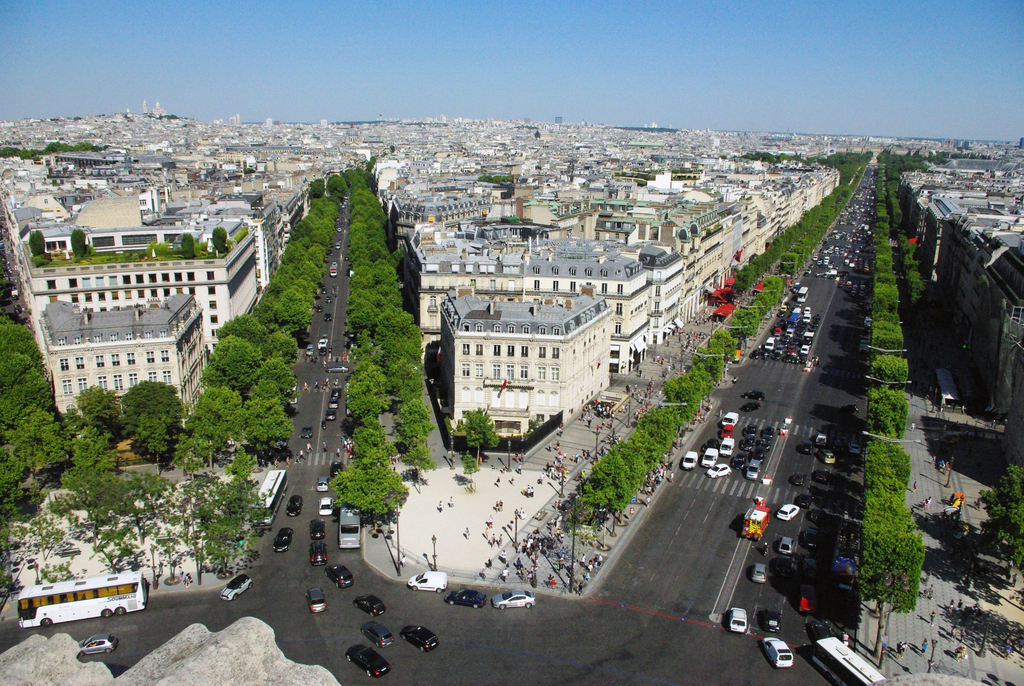 The view from the Arc de Triomphe © French Moments
The view from the Arc de Triomphe © French Moments
You also get a fine view over the whole Historical Axis, from the Louvre to the Grande Arche in the CBD of La Défense.
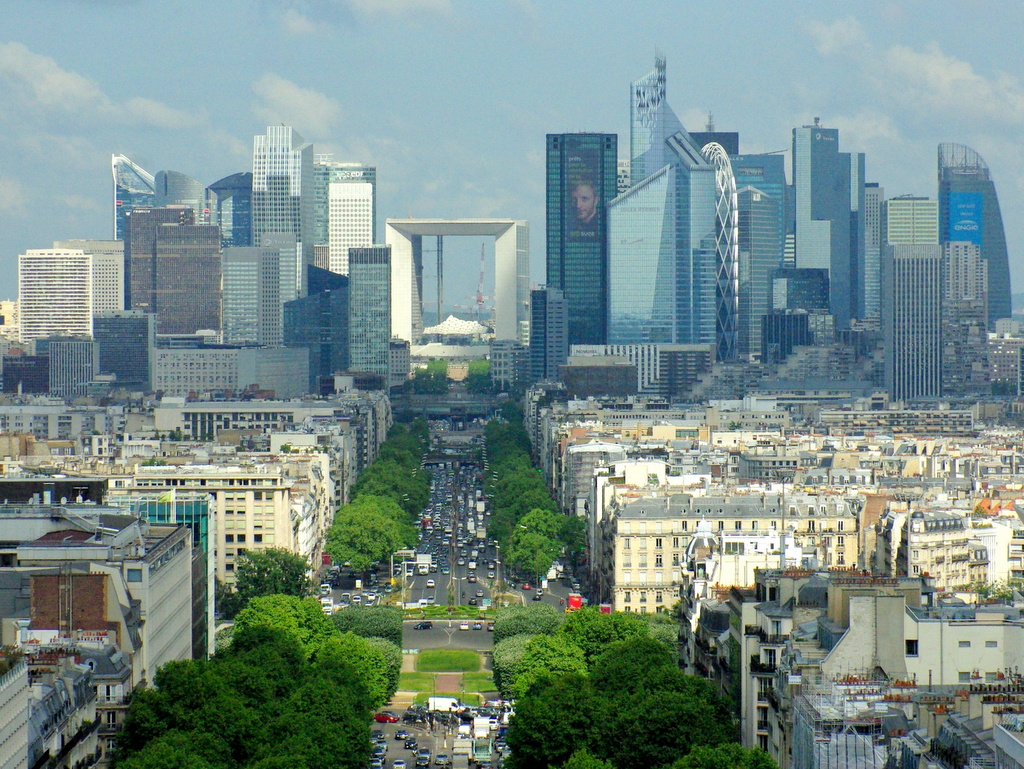 The business district from the Arc de Triomphe © French Moments
The business district from the Arc de Triomphe © French Moments
The star of the Arc de Triomphe
Let’s reflect a moment on this.
A triumphal arch as a centre of a round-shape square.
From which 12 avenues form the radiating lines of a perfect star.
Set on a monumental historical axis on which various famous landmarks are aligned…
Well, how amazing is that!
But the Arc de Triomphe does not close the perspective as it used to do until the 1980s. For French leaders, anything is possible! President Mitterrand was ambitious.
He wished to expand the great perspective beyond the Arc de Triomphe by erecting an even larger, taller and wider monument: the Grande Arche de la Défense.
Read more about the position of the Arc de Triomphe in Paris.
The Historical Axis of Paris reaching La Défense
 La Défense CBD viewed from Arc de Triomphe © French Moments
La Défense CBD viewed from Arc de Triomphe © French Moments
The idea to link the Louvre to Saint-Germain en Laye with a straight road over the little hill of Chantecoq (the site of the Grande Arche) emerged during the 15th century.
During the reign of Louis XIV, the axis became the obligatory route to reach the forest of Saint-Germain. The thoroughfare was strictly aligned on the Historical Axis that architect Le Nôtre had worked on from the Tuileries Palace.
In the 1950s, the authorities decided to create a significant business centre outside Paris in the residential and industrial district of La Défense. It is a plethora of skyscrapers whose tallest reach 230 metres.
La Grande Arche de la Défense
In the midst of the skyscrapers bordering the Historical Axis in La Défense, French President Mitterrand wanted to build a strong unifying symbol for the bicentenary of the French Revolution (1989): La Grande Arche.
The gigantic and stunning monument is 110 metres tall by 112 metres deep and could hold the Notre-Dame Cathedral within its arch.
The Grande Arche occupies a ‘place of honour’ on the western extremity of the Historical Axis of Paris.
But the urban planners of the 1980s also positioned it in such a way that it forms another perspective. This is visible from the top of the monument. You’ll see how it stands in perfect alignment with the Eiffel Tower and the Tour Montparnasse, two of France’s tallest buildings.
Read more about the CBD of La Défense.
Striking facts about the Historical Axis of Paris
Let’s focus on some striking facts about the Historical Axis of Paris, starting with the three arches.
Remember the three arches placed along the axis?
- Arc de Triomphe du Carrousel,
- Arc de Triomphe de l’Etoile, and
- Grande Arche.
Well, they all share a striking fact: their sizes approximately double at each stage!

And there is more! Let’s have a look at the distances between the major landmarks along the Historical Axis. They double each time!
- 1 kilometre from the Arc de Triomphe du Carrousel to the Luxor Obelisk,
- 2 kilometres from the Obelisk to the Arc de Triomphe, and
- 4 kilometres from the Arc de Triomphe to the Statue of La Défense de Paris on the Esplanade de la Défense.
Is this out of a coordinated deliberation or just a coincidence?

For some, it follows a careful plan transmitted from generation to generation.
A Freemasonry scheme could be behind it, maybe related to a strong Egyptology intrigue.
For others, monuments were just added over time, and even though they represent a symbolic meaning, their alignment was no obscure mystery.
The Historical Axis in the Future
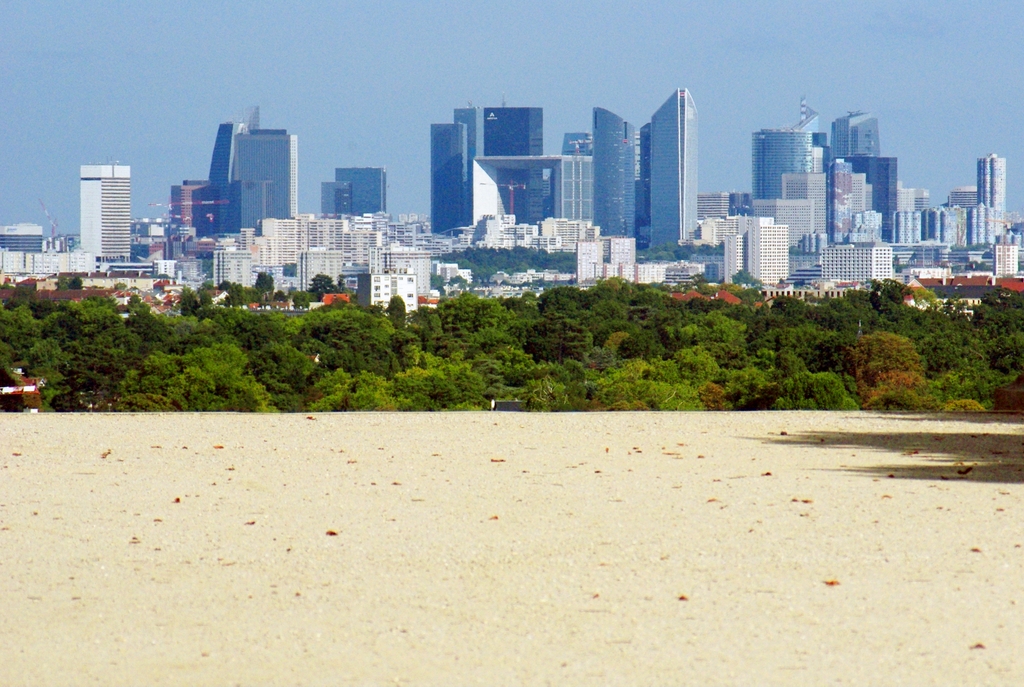 La Défense from the terrace of Le Nôtre, Saint-Germain-en-Laye © French Moments
La Défense from the terrace of Le Nôtre, Saint-Germain-en-Laye © French Moments
Today the Historical Axis of Paris does not end at the Grande Arche anymore.
The journey continues beyond it, to the next meander of the Seine. When complete, this large-scale urban planning project will extend the axis by 3.5 km through a series of terraces, although with a slight curve.
Urban architects are redesigning the landscape through the suburb of Nanterre. The goal is to hide away the stretch of land which has, over the years, become a no-man’s land at the feet of the Grande Arche.
Eventually, the Historical Axis will be 11.5 km long. It will make a great walk from the Louvre to the Seine River in Nanterre. Who knows… maybe one day the Historical Axis of Paris will reach the forest of Saint-Germain en Laye. This is complete what Louis XIV the Sun King had once wished!

Find out more!
These are external websites:

